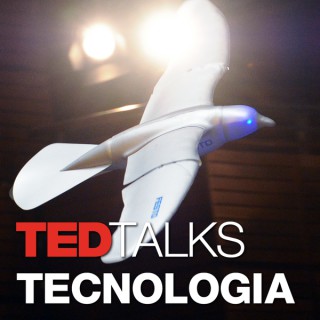Podcast appearances and mentions of raphael arar
- 8PODCASTS
- 8EPISODES
- 30mAVG DURATION
- ?INFREQUENT EPISODES
- Jul 6, 2023LATEST
POPULARITY
Latest podcast episodes about raphael arar
2516. 126 Academic Words Reference from "Raphael Arar: How we can teach computers to make sense of our emotions | TED Talk"
This podcast is a commentary and does not contain any copyrighted material of the reference source. We strongly recommend accessing/buying the reference source at the same time. ■Reference Source https://www.ted.com/talks/raphael_arar_how_we_can_teach_computers_to_make_sense_of_our_emotions ■Post on this topic (You can get FREE learning materials!) https://englist.me/126-academic-words-reference-from-raphael-arar-how-we-can-teach-computers-to-make-sense-of-our-emotions-ted-talk/ ■Youtube Video https://youtu.be/-pU27mHCTOg (All Words) https://youtu.be/PF3YKCGWByk (Advanced Words) https://youtu.be/wf_dWPQyzUI (Quick Look) ■Top Page for Further Materials https://englist.me/ ■SNS (Please follow!)
#62: AI in Design and Art - former Senior Design Khan Academy, Professor, One Project (Raphael Arar)
By Raphael (Forbes 30 under 30 in Enterprise technology): I work at the nexus of complex systems, transdisciplinary design and arts-based research. For the past decade, I've helped others both untangle messes and uncover opportunities through a balancing act of problem-solving and creative inquiry. I currently lead Alternatives at One Project, where we're working to design, implement and scale new forms of economics and governance that are equitable, ecological and effective. I also serve as a Board Member at Leonardo, the International Society for the Arts, Sciences and Technology. Previously, I led design for learners at Khan Academy, tackled ethical platforms of AI at IBM Research, taught media theory at the USC School of Cinematic Arts and designed over a hundred iOS apps with Apple. My artwork has been shown at museums, conferences, festivals and galleries internationally including the ZKM | Center for Art and Media, SLAC National Accelerator Laboratory, International Symposium on Electronic Art (ISEA), Gamble House Museum, ACM CHI Conference on Human Factors in Computing Systems, Boston Cyberarts Gallery, and Athens Video Art Festival. Commercially, my work has been featured in publications including Inc. Magazine, FastCompany, Wired and others, and in 2017, I was listed as one of Forbes's “30 under 30” in Enterprise Technology. 0:00 - Introduction Raphael 1:04 - How his interest in complex systems evolved 4:10 - How he applied his skills to education 7:21 - Democratising & scaling education (fostering children's intrinsic motivation for education) 14:30 - Changing an extrinsic motivation to an intrinsic one 18:16 - Working at IBM Research 22:04 - Changes in education during the pandemic & is there an optimal solution? 37:32 - How recent changes (e.g., the rapid growth of technology & Web 3.0) are affecting schooling 48:33 - How can you combine a decentralized economy with education? 50:52 - Raphael's current work at “One Project” ... Join Our Facebook Group Community here: http://bit.ly/sfe-community Listen to our SFE podcast - Impact Talks on Anchor or Spotify: https://startupfundingevent.com/podcast/ Created by https://www.lightningvideoeditors.comra
How we can teach computers to make sense of our emotions | Raphael Arar
How can we make AI that people actually want to interact with? Raphael Arar suggests we start by making art. He shares interactive projects that help AI explore complex ideas like nostalgia, intuition and conversation -- all working towards the goal of making our future technology just as much human as it is artificial. Hosted on Acast. See acast.com/privacy for more information.
How we can teach computers to make sense of our emotions | Raphael Arar
How can we make AI that people actually want to interact with? Raphael Arar suggests we start by making art. He shares interactive projects that help AI explore complex ideas like nostalgia, intuition and conversation -- all working towards the goal of making our future technology just as much human as it is artificial.
사람과 진심으로 교감할 수 있는 AI는 어떻게 만들 수 있을까요? 라파엘 아라르(Raphael Arar)는 예술로부터 그 과정을 시작하자고 제안합니다. 그는 그리움, 직감 및 대화와 같은 복잡한 개념을 AI에게 가르치기 위해 그가 창조했던 쌍뱡향 예술 프로젝트를 공유합니다. 인간만큼이나 인간적인 미래 기술 구현을 향한 그의 노력을 확인해봅시다.
Cómo enseñar a los ordenadores a dar sentido a nuestras emociones | Raphael Arar
¿Cómo podemos crear una IA con la que la gente quiera interactuar?. Raphael Arar sugiere que empecemos por hacer arte. Él comparte projectos interactivos que ayudan a la IA a explorar ideas complejas como la nostalgia, la intuición y conversación; todas trabajando para que la tecnología futura sean tan humana como artificial.
Como podemos ensinar computadores a entender nossas emoções | Raphael Arar
Como criamos uma IA com que as pessoas realmente queiram interagir? Raphael Arar sugere que comecemos criando arte. Ele compartilha projetos interativos que ajudam a IA a explorar ideias complexas como nostalgia, intuição e conversação, tudo trabalhando com a intenção de tornar a tecnologia do futuro tão humana quanto ela é artificial.
Comment apprendre aux ordinateurs à trouver du sens dans nos émotions | Raphael Arar
Comment pouvons-nous créer une intelligence artificielle avec qui les gens voudraient interagir ? Raphael Arar suggère de commencer par l'art. Il nous parle de projets interactifs qui aident l'intelligence artificielle à mieux comprendre des idées complexes comme la nostalgie, l'intuition et la discussion – pour faire en sorte que la technologie du futur soit autant humaine qu'artificielle.











